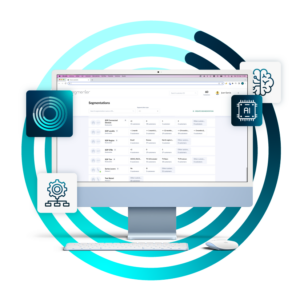
After more than 40 years of operation, DTVE is closing its doors and our website will no longer be updated daily. Thank you for all of your support.
Advanced audience segmentation: clustering and personalising the user experience with AI
 Streaming service providers have looked to segment their audiences according to broad-brush criteria, often to deliver targeted advertising. But segmentation has far greater potential. Mirada director of product development Santiago Rodriguez explains how innovation in this area can help service providers improve engagement, reduce churn and add to customer satisfaction.
Streaming service providers have looked to segment their audiences according to broad-brush criteria, often to deliver targeted advertising. But segmentation has far greater potential. Mirada director of product development Santiago Rodriguez explains how innovation in this area can help service providers improve engagement, reduce churn and add to customer satisfaction.
As top-line subscriber growth for premium streaming services tails off and the battle between service providers for the entertainment spend of increasingly cash-strapped users intensifies, the industry collectively is focusing more attention on customer data.
 Specifically, streaming providers recognise a need to make the best possible use of their key asset – the information they possess about the identities, tastes and spending power of their customers – to ensure that those customers stay with their offering and, ideally, spend a bit more of their hard-earned money with them.
Specifically, streaming providers recognise a need to make the best possible use of their key asset – the information they possess about the identities, tastes and spending power of their customers – to ensure that those customers stay with their offering and, ideally, spend a bit more of their hard-earned money with them.
That is no easy task.
“The obvious challenge is to have appropriate data and relevant metrics with which to work because there are many cases where service providers either do not have relevant data or they have too much data from too many different sources,” says Santiago Rodriguez, director of product development at user experience technology specialist Mirada.
To make sense of data from disparate sources there is, he says, an urgent need for specialist data analytics tools “to get a clear and integrated view of the video service”.
Service providers, says Rodriguez, must decide what they want to do with the data available to them as well as which data to select. In addition, they need to have tools not only to enable them to understand their own data but to react to it, for example by changing how an offering is presented to consumers. “The tools need to be usable by marketing people, not just by technical people,” he says.
Knowing what to do with the data means knowing how to segment the audience for the best possible results, according to Rodriguez.
Segmentation allows content service providers to classify and group users that share a set of common characteristics. Audience segmentation is not new. Until now, it has typically meant what Rodriguez characterises as “declarative segmentation”. Service providers create broad audience segments based on a few well-established parameters such as the area where the subscriber lives and on past consumption patterns. Recommendations and targeted content – particularly the line-up of channels and partial catalogues – have traditionally been delivered based on this.
Declarative and inferred segmentation
This form of broad-brush segmentation is limited in its practical application and its potential to improve customer loyalty and satisfaction, he suggests. More recently, attempts have been made to develop more advanced audience segmentation strategies. However, these strategies, based on a closer reading of user consumption habits, have mostly been applied to increase revenue based on targeted advertising, rather than as part of a concerted move to increase loyalty, says Rodriguez.
Even where service providers look beyond the immediate goal of delivering cash revenues from addressable advertising, “often they do not have the tools” to do more, such as using segmentation to improve customer loyalty and the ‘stickiness’ of services, says Rodriguez.
Effective segmentation means having clear business goals to start. With these goals in mind, operators can use advanced technology to segment in a much more sophisticated way than has been the case in the past, going beyond demographic data to analyse a broad range of factors such as payment methods used, content packages included in subscriptions and engagement levels. Other factors that can feed into advanced segmentation include behavioural patterns such as amount of time spent on the service and which devices are preferred to watch which types of content.
Mirada recently introduced an advanced AI clustering engine to its existing Segmenter tool to bring artificial intelligence and machine learning techniques to user segmentation.
Segmenter itself is a backend tool that forms part of Mirada Iris, its end-to-end solution to deliver viewing experiences across devices.
The company says that integration with the data analytics and business intelligence tool LogIQ enables Mirada’s advanced clustering engine to achieve inferred user segmentations using AI and machine learning.
All of this can help service providers identify, or infer, more granular (and continually shifting) audience segments to generate micro-targeted marketing campaigns and recommendations.
“Data is the fuel and artificial intelligence is the engine. Together, they make audience segmentation and hyper-personalisation move, but you still need the whole car to articulate that segmentation into an integrated, differentiated video experience that becomes essential to the viewer,” says Rodriguez.
This technology, he suggests, combining well-known demographic attributes with an unprecedently sophisticated understanding of preferences and behaviours, can be used to profile viewers with a very high degree of precision and can be used to develop campaigns, recommendations and actions designed to reduce churn, maximise customer loyalty and increase engagement.
In this way, Segmenter, powered by advanced AI clustering, can be applied to “infer not only viewers’ interests and preferences, such whether they prefer drama or sports, but their behaviour, age, gender, family composition, engagement with a service and value to the provider,” says Rodriguez.
“The best part of all this is that different clusters can be combined. You can combine these inferred clusters with location data, devices being used and declarative segments, along with segmentation from external, third-party sources.”
‘Divide and conquer’
With these tools to hand, Mirada holds that service providers can adopt a policy of ‘divide and conquer’, with measurable improvements in customer loyalty and engagement.
They can, for example, deliver a more personalised UI and presentation of a content offering in a few minutes and with a few clicks through the integration of Mirada’s Segmenter and UXEvolver tools. Thanks to Mirada’s recent integration with Promolab, they can also serve push notifications and personalised ads to customer micro-segments.
However, there is an important caveat. While hyper-personalisation can certainly boost loyalty in theory, the capacity of service providers to cater to as many cases as they have subscribers is limited. There is still a need to strike a balance between the capabilities of the technology and the service provider’s capacity to manage individualised offerings.
“Service providers in this case may prefer to focus their biggest efforts on well-established, high-value customers – for example middle-aged customers with kids and high disposable income who have exhibited loyalty to the service,” says Rodriguez.
“This is the kind of customer you wouldn’t want to lose, but who may have the potential to contribute more. So you may wish to proactively offer such families an upgrade with content that suits their interests. Or if they drop down to a cluster with a lower level of engagement, a provider may offer them a discount or some kind of promotion to reconnect them. In addition, if they join a segment of users experiencing poor Quality of Service, their provider may proactively give them a call to address the issues they have.”
For customers who may, on the surface, appear to be less valuable – such as those who habitually binge on content from one provider before churning and signing up with another – it may not be worthwhile to give additional personalised customer care, but it may be possible to re-engage via a personalised user experience that highlights their interests.
Similarly, users who are indifferent to whether the content they are viewing is in standard or ultra high-definition could be served in a more cost-efficient way.
“Not every viewer perceives the same or reacts in the same way to a given level of Quality of Service – it can be very subjective,” says Rodriguez. Viewers who do not perceive much difference between higher and lower resolution could be served lower bitrate video at little cost.
In short, serving lower-value customers also lends itself to a personalised approach.
Mirada’s toolset also enables content service providers to automate much of the work, for example in generating and measuring the results of A/B testing of initiatives.
For Rodriguez, the approach embodied by Segmenter and Mirada’s advanced AI Clustering engine, combined with greater use of automation, will make ever-more hyper-personalised offerings practical for service providers to implement.
He adds a second caveat. People can now detect when they are being served recommendations generated by algorithm and may start to resent being manipulated. However, this may also present an opportunity for the more sophisticated segmenting made possible by AI.
“People like to receive recommendations from people in their own community or tribe or from friends. They value the human touch, and that is a possible limitation to all of this,” he says.
“However, AI-based segmentation can actually bring you closer to the community or tribe-based recommendation – much closer to it than individualised recommendations and I think this will lead to better results.”
This is sponsored content.
